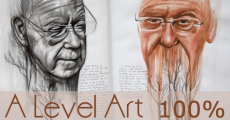

Tips for A level Art
So back to the personal investigation, when looking for where you want to go with your project, it is a good idea to show this in your sketchbook. Examiners want to know where your ideas have come from, what inspired you and what your hopes for the project are. It does not matter if you take your project in the complete opposite direction, in fact, that makes it more interesting! Changing the direction of your project shows you are open to trying new ideas.
If you visit a gallery, demonstrate it! Do some sketches, take some photographs, write about what you saw, what you liked, what you did not like. Talk about what stood out. Did anything inspire you? Inspiration does not just have to come from the gallery. I once found inspiration on my way to the gallery, watching people whilst on public transport, and yes, I put this in my sketchbook!
Once you are done looking for initial inspiration, time to start doing detailed explorations of artists. Pick your artists carefully, don’t just throw them in your sketchbook for the sake of it. How does this artist influence or inspire you, what impact do they have on your project, what do you like about the artist, what do you not like about this artist? Where did the artist get his or her inspiration from? Really research the artist you have picked, try understand what they want to portray but also interpret the work however you wish. Start of with some written research, then produce a copy of their work. Then analyse the copy you made, describe why you chose to copy the painting, and what decisions you made when making the copy. For example, did you use paint, pencil, pen, and why? What size did you do the copy, and why? Remember, not everything needs to fit into your sketchbook. You can create big pieces, take a photo of them and then stick them in. if you choose to do this, it would be good to create a portfolio as well. And remember, it is not compulsory to even do a sketchbook, and it is definitely not compulsory to fill every page of one! Once you have done the copy, evaluate it too. Next create your own response. Or multiple responses. Expand on your ideas, refine bits, make it better, experiment with new materials. Do the same piece, but in a different way. Review what you have done, what do you like, what ideas do wish to carry on with. Once you get started with responses, ideas will begin to flow. It is important to show everything you do, and talk about why. It’s like writing down a recipe, have step by step instruction of what to do, to make the final product. With all ideas you have created, you need to start leaning towards a final idea. Start by making some mock-ups, this could either be bringing together work you have already done, or focussing on one thing in particular. Create as many mock-ups as you like.
image- https://www.studentartguide.com/featured/enjoy-a-level-art-exam

0 Comment:
Be the first one to comment on this article.